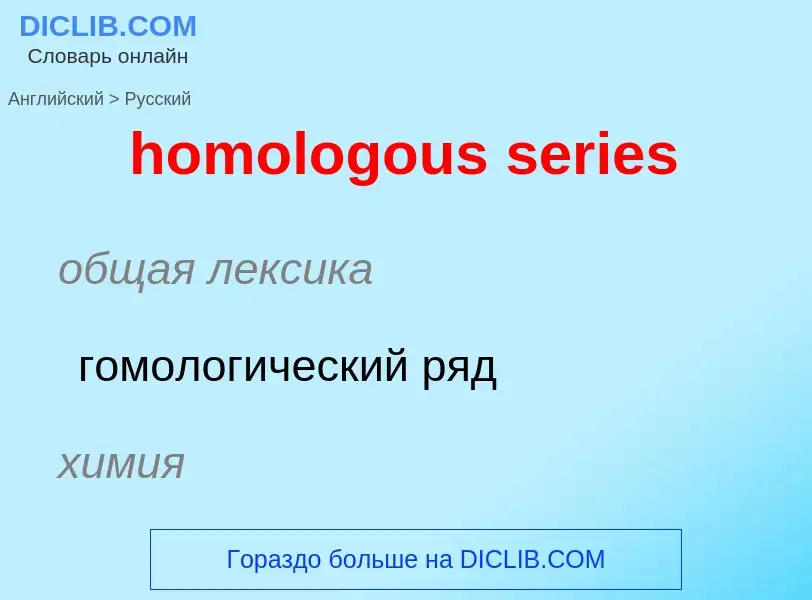Translation and analysis of words by ChatGPT artificial intelligence
On this page you can get a detailed analysis of a word or phrase, produced by the best artificial intelligence technology to date:
- how the word is used
- frequency of use
- it is used more often in oral or written speech
- word translation options
- usage examples (several phrases with translation)
- etymology
homologous series - translation to russian
общая лексика
гомологический ряд
химия
ряд гомологический
общая лексика
гомолог
синоним
Definition
Wikipedia
In organic chemistry, a homologous series is a sequence of compounds with the same functional group and similar chemical properties in which the members of the series can be branched or unbranched, or differ by molecular formula of CH2 and molecular mass of 14u. This can be the length of a carbon chain, for example in the straight-chained alkanes (paraffins), or it could be the number of monomers in a homopolymer such as amylose.
Compounds within a homologous series typically have a fixed set of functional groups that gives them similar chemical and physical properties. (For example, the series of primary straight-chained alcohols has a hydroxyl at the end of the carbon chain.) These properties typically change gradually along the series, and the changes can often be explained by mere differences in molecular size and mass. The name "homologous series" is also often used for any collection of compounds that have similar structures or include the same functional group, such as the general alkanes (straight and branched), the alkenes (olefins), the carbohydrates, etc. However, if the members cannot be arranged in a linear order by a single parameter, the collection may be better called a "chemical family" or "class of homologous compounds" than a "series".
The concept of homologous series was proposed in 1843 by the French chemist Charles Gerhardt. A homologation reaction is a chemical process that converts one member of a homologous series to the next member.

 from methane to nonadecane.png?width=200)
![analogous]] but not homologous to an insect's wings. analogous]] but not homologous to an insect's wings.](https://commons.wikimedia.org/wiki/Special:FilePath/Acer pseudoplatanus MHNT.BOT.2004.0.461.jpg?width=200)



![The [[Cretaceous]] snake ''[[Eupodophis]]'' had hind legs (circled). The [[Cretaceous]] snake ''[[Eupodophis]]'' had hind legs (circled).](https://commons.wikimedia.org/wiki/Special:FilePath/Eupodophis at Royal Belgian Institute of Natural Sciences, Brussels.jpg?width=200)


![''[[pax6]]'' alterations result in similar changes to eye morphology and function across a wide range of taxa. ''[[pax6]]'' alterations result in similar changes to eye morphology and function across a wide range of taxa.](https://commons.wikimedia.org/wiki/Special:FilePath/PAX6 Phenotypes Washington etal PLoSBiol e1000247.png?width=200)

![One [[pinnate]] leaf of [[European ash]] One [[pinnate]] leaf of [[European ash]]](https://commons.wikimedia.org/wiki/Special:FilePath/EurAshLeaf.jpg?width=200)
![palm]] leaf palm]] leaf](https://commons.wikimedia.org/wiki/Special:FilePath/Detail on a palm frond (8297623365).jpg?width=200)
![storage]] leaf of ''[[Aloe]]'' storage]] leaf of ''[[Aloe]]''](https://commons.wikimedia.org/wiki/Special:FilePath/Split Aloe.jpg?width=200)
![Insect-trapping leaf of [[Venus flytrap]] Insect-trapping leaf of [[Venus flytrap]]](https://commons.wikimedia.org/wiki/Special:FilePath/Venus Flytrap showing trigger hairs.jpg?width=200)
![Insect-trapping leaf of [[pitcher plant]] Insect-trapping leaf of [[pitcher plant]]](https://commons.wikimedia.org/wiki/Special:FilePath/Nepenthes muluensis.jpg?width=200)
![Food storage leaves in an [[onion]] [[bulb]] Food storage leaves in an [[onion]] [[bulb]]](https://commons.wikimedia.org/wiki/Special:FilePath/Onions 002.jpg?width=200)
